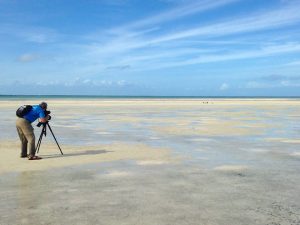Piping Plovers in the Bahamas
Our Work isn’t Done – the Ongoing Importance of Band Resighting
By Todd Pover, Senior Wildlife Biologist
Earlier in January, I attended the Abaco Science Alliance Conference to make a presentation about recent conservation and research developments for piping plovers in the Bahamas. This marks the eighth year, starting in 2011, either solo or with CWF staff and other colleagues, that I have been able to follow piping plovers to their wintering grounds in the Bahamas to conduct work to better understand and help recover this at-risk species. And in another sense, to be an international ambassador for piping plovers.

Over that time, the focus of those trips has varied widely, including conducting surveys for the International Piping Plover Census in 2011 and 2016, improving our understanding of how piping plovers use the various habitats, engaging students with our Shorebird Sister School Network from 2014-17, helping Friends of the Environment, our primary partner there, integrate piping plovers into their educational/school programs, building conservation partnerships, and even producing a video. Tremendous positive changes have occurred in that time with regard to awareness of and attitudes towards piping plovers in the Bahamas and some significant conservation progress has been made, most notably the establishment of several new national parks by the Bahamian government that help protect piping plovers and other shorebirds.
So, is our work done there? The simple answer is no, but this is a fair question, considering collectively we have now likely catalogued most of the significant distribution and hotspots for piping plovers in the Bahamas and appreciably raised awareness about the important role the Bahamas plays for this species. But even with some highly critical habitat for piping plovers now having protected status as a result of this initiative, other areas potentially remain vulnerable to threats from development and commercial use. By recent accounts, tourism, including to the Out Islands where most of the piping plovers are located, has started to wake from its slumber, which is great for the local economy, but must always be tempered with a concern about impacts to the fragile environment. In the best-case scenario, the Bahama’s incredible natural beauty is its star attraction, so it is in the interest of everyone to protect the environment and the species using it, but this doesn’t happen without ongoing advocacy and support generated by conservation education.
Aside from those concerns, some important research questions still remain and the Bahamas may hold a key to answering them. Much progress has been made towards recovery for piping plovers; by virtue of intensive monitoring on the breeding grounds, we know breeding pairs along the Atlantic Coast of the U.S. and Canada have increased from just 790 pairs when federal listing occurred in 1986 to 1941 pairs in 2016, more than doubling the population and approaching the recovery goal of 2000 pairs. Unfortunately, the recovery has not been balanced throughout the range. The vast majority of the increase has come in the New England region, with our New York-New Jersey region and Atlantic Canada notably lagging behind. In the case of our local breeders here in New Jersey, we think consistently low breeding success is causing the population to stagnate. Typically, if you successfully produce more young, eventually adult breeding abundance also rises because the birds tend to return to the same general area, but adequate reproductive success has hasn’t been the case in this region.
The decline in Atlantic Canada breeders is more of a mystery. The number of fledglings produced here is often high, but the breeding population has not followed the trend seen elsewhere in the range and increased, as would be expected. A greater number of these birds are being lost sometime between when they are last seen on the breeding grounds and when they should be returning from their southern wintering grounds (after two migrations) to breed again. But where are they lost…immediately post-breeding while they stage, during migration, when they are wintering? Is mortality higher at certain sites or regions along the migration flyway or during the wintering period? Do hurricanes, common in the Bahamas, play a major role? What impact do prolonged cold snaps have on plovers wintering in the Southeast U.S.?

Bands that mark individual birds are a key to figuring this out as they allow us to track movements and detect survival rates of piping plovers. Several researchers working with the piping plover conservation community are now using resight information to try to determine if survival differs by wintering region or what impact these other factors play. With the majority of our Atlantic Coast population, including birds breeding in New Jersey, wintering in the Bahamas, ongoing surveys and especially band resighting of birds wintering there provide valuable information to help answer these questions.
So, in the days leading up the recent Abaco Science Alliance Conference and immediately before or after each day’s presentations, during any spare daylight hours, you could find me grabbing my binoculars and spotting scope and heading out to look for piping plovers. Time was limited, but I managed to find 136 plovers in a few short days, but more importantly, a sizeable number of banded ones, the “holy grail” of information I am seeking most these days to help advance the science and recovery of piping plovers.
Discover more from Conserve Wildlife Foundation of NJ
Subscribe to get the latest posts sent to your email.